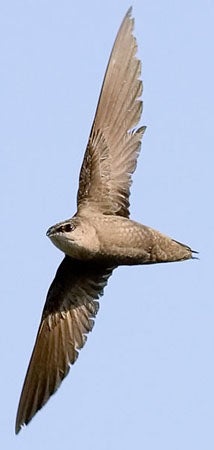SCIENTIFIC NAME:
Chaetura pelagica
STATUS:
Breeder. Common in spring, summer, and fall in all regions. MODERATE CONSERVATION CONCERN.
DESCRIPTION:
Chimney swifts, Chaetura pelagica, are generally 4 ¾ to 5 ½ inches long. They are an all dark charcoal grey color above and slightly paler color underneath. Many people describe them flying as a “cigar with wings”. It has long, narrow, pointed wings and a thick short body. The tail is very short with spiny tips. Its flight is similar to that of a bat, with the wings appearing as though they beat alternately rather than in unison. This illusion is the result in part from the frequent flying patterns of banking and turning. The call of this species is a loud chippering.
DISTRIBUTION:
The chimney swift is one of about 80 species worldwide and four that regularly occur in North America. It is the most common swift species that occurs throughout the eastern half of the United States during the breeding season. They are common to abundant in Alabama during the breeding season. During the winter, they will migrate to South America.
HABITAT:
The chimney swift historically nested in hollow trees. Today, most will nest in man-made structures. Dark hollow shafts such as masonry chimneys, air shafts made of wood or brick , bar-b-que pits and abandoned grain silos are often used for roost and nesting sites. They do not sit on perches like most birds; instead they use their long claws to cling to the walls of vertical structures. Recent changes in chimney design, with covered, narrow flues, have decreased the available nest sites and may be a factor in declining population numbers. Swifts are among the most aerial of birds, flying almost constantly except when at the nest or roosting at night. They will even bathe in flight, gliding down to water and smacking the surface with its breast, then bouncing up and shaking the water from its plumage as it flies away.
FEEDING HABITS:
The diet of the chimney swift consists of flying insects. Insects are captured in their bill and consumed during the flight. They will feed in flocks or alone.
LIFE HISTORY AND ECOLOGY:
The breeding season usually begins in early May, peaks later that month, and extends to mid-July. Most of the breeding occurs in urban areas, due to the occurrence of preferred nesting structures. The nest is a half-saucer shape made out of twigs and other plant material, which the bird attaches together and to the wall of a chimney using saliva. Females will lay three to six eggs that both adults take turns incubating for 19 to 21 days. The young will leave the nest 28 to 30 days after hatching. An additional male or female, called a helper, may assist the adults incubate the eggs and feed the nestlings.
REFERENCES:
Swifts. In The Georgia Museum of Natural History and Georgia Department of Natural Resources Website.
Chimney swift. All About Birds. Cornell Lab of Ornithology Website: http://www.birds.cornell.edu/AllAboutBirds/BirdGuide/Chimney_Swift_dtl.html.
Kyle, Paul D. and Georgean Z. Chimney Swift. In The Texas Breeding Bird Atlas.Texas A&M University Website: https://txtbba.tamu.edu/?s=chimney+swift.
AUTHOR:
Jeff Makemson, Wildlife Biologist, Alabama Division of Wildlife and Freshwater Fisheries






